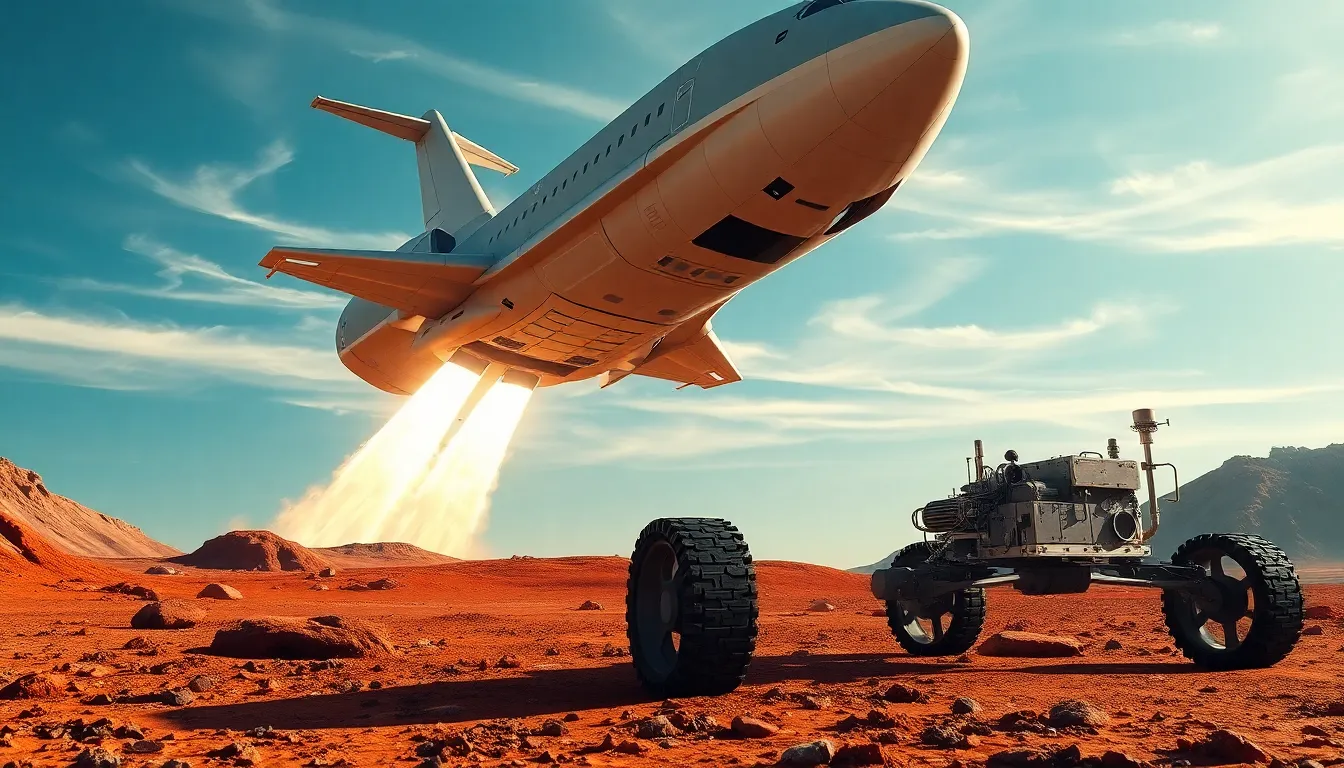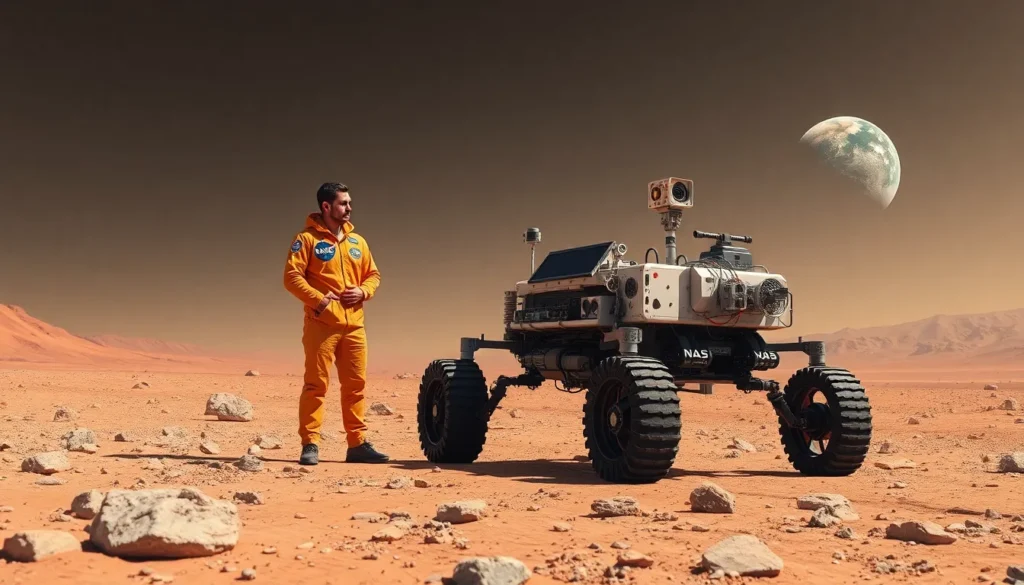Table of Contents
ToggleIn a universe filled with twinkling stars and the occasional rogue asteroid, space exploration technology is the rocket fuel propelling humanity into the great unknown. Forget about the days of squinting at the night sky and wondering what’s out there; now, we’ve got robots and satellites doing the heavy lifting. From Mars rovers that send selfies back to Earth to telescopes peering into the very fabric of time, technology is transforming our cosmic dreams into reality.
Overview of Space Exploration Technology
Space exploration technology includes a range of advanced tools and systems that facilitate the study of the universe. Robotic missions play a pivotal role in gathering data from distant celestial bodies. Examples include the Mars rovers, which operate autonomously and send valuable images back to Earth.
Satellites are crucial for monitoring planetary conditions and tracking cosmic events. They provide real-time data on weather patterns, space debris, and radiation levels. Instruments like the Hubble Space Telescope continue to deepen humanity’s understanding of galaxies and stellar formations while providing stunning visuals.
Launch vehicles, such as SpaceX’s Falcon 9, demonstrate advancements in reusability and cost efficiency. These innovations lead to more frequent and affordable access to space. Communication systems aboard spacecraft ensure data transmission to Earth remains robust.
Habitat technology enables long-duration human missions in space. NASA’s Orion spacecraft is designed to support astronauts on deep space exploration activities. Life support systems maintain essential conditions for crew members, showcasing how human presence in space is becoming feasible.
Exploration robotics continue to evolve, enhancing capabilities on celestial surfaces. Rovers equipped with advanced sensors collect soil samples and analyze chemical compositions. Newer initiatives target the establishment of bases on the Moon and Mars, pushing the boundaries of human settlement.
This collection of technologies illustrates a significant leap forward from mere observation to hands-on investigation, reinforcing ambitions for comprehensive exploration of space.
Key Innovations in Space Exploration

Innovations in space exploration technology drive humanity’s quest to understand the universe. Key advancements enhance robotic capabilities and propulsion systems, paving the way for deeper exploration.
Robotics and Automation
Robotics plays a critical role in space missions. Rovers like Curiosity and Perseverance autonomously navigate challenging terrains on Mars. These robots conduct experiments and gather data, significantly contributing to the scientific community’s knowledge. Equipped with sophisticated tools, they analyze soil samples and capture high-resolution images. Automation in spacecraft also streamlines operations, making missions more efficient. Robotic arms assist astronauts in tasks beyond the confines of their spacecraft. These advancements reduce reliance on human presence, enabling missions to distant celestial bodies.
Propulsion Systems
Propulsion systems evolve rapidly, enhancing the efficiency of space travel. Traditional chemical rockets remain key, but innovations like ion propulsion systems offer greater fuel efficiency. These systems use electric power to accelerate ions, providing sustained thrust over long periods. The development of nuclear thermal propulsion also promises faster travel times for crewed missions to Mars. Such advancements will shorten the journey, improving mission feasibility. Emerging technologies, including solar sails, harness solar radiation for propulsion. As propulsion options expand, they open new pathways for exploration beyond our solar system.
Current Applications of Space Exploration Technology
Space exploration technology transforms how humanity engages with the cosmos. Several applications demonstrate this advancement effectively.
Satellites and Communication
Satellites play a crucial role in modern space exploration. These devices gather data on weather patterns, climate changes, and cosmic events. They provide high-resolution images of Earth and other celestial bodies. Communication satellites facilitate global connectivity, supporting telecommunication networks and internet services. Real-time data relay significantly enhances scientific research and disaster management efforts. Organizations like NASA and private companies rely on satellites for telemetry and navigation. These essential tools ensure mission success and sustain ongoing exploration efforts.
Human Spaceflight
Human spaceflight represents a significant achievement in exploration. Manned missions enable researchers to conduct experiments in microgravity environments. NASA’s International Space Station functions as a laboratory for studying biological and physical sciences. Crews aboard these missions develop technologies for life support and habitat sustainability. Notable missions, such as SpaceX’s Crew Dragon, showcase advancements in launch safety and reliability. By focusing on long-duration flights, researchers prepare for future missions to Mars and beyond. Human spaceflight connects people with the universe, fostering a sense of adventure and curiosity about our solar system.
Future Trends and Developments
The future of space exploration technology promises groundbreaking advancements. Exciting innovations are on the horizon, enhancing humanity’s ability to explore beyond Earth.
Mars Colonization Efforts
Efforts to colonize Mars are gaining momentum, driven by both governmental and private initiatives. NASA’s Artemis program lays plans for sustainable human presence on the Moon, serving as a precursor for Mars missions. SpaceX’s Starship aims to facilitate trips to Mars, focusing on large-scale transport for astronauts and cargo. Technological developments in habitat construction and life support systems will support long-term stays. Robotic missions continue to prepare the Martian environment for human arrivals, with missions targeting resource utilization for survival. Exploration plans prioritize the establishment of permanent bases, enhancing humanity’s ability to thrive on the Red Planet.
Advancements in AI and Machine Learning
Artificial intelligence and machine learning are transforming space exploration technology. These systems enhance autonomous navigation, allowing rovers to analyze and adapt to complex environments. Algorithms process vast amounts of data, improving decision-making during missions. NASA’s Perseverance rover utilizes advanced AI to identify geological features of interest. Machine learning significantly speeds up data analysis, enabling scientists to draw insights from cosmic data quicker. Future missions plan to incorporate even more sophisticated AI systems, facilitating real-time decision-making during exploration and enhancing operational efficiency.
The evolution of space exploration technology marks a pivotal moment in humanity’s quest to understand the universe. With advancements in robotics propulsion systems and artificial intelligence the barriers to exploration are continuously being pushed. As missions evolve from Earth-based observations to hands-on investigations the potential for discovery grows exponentially.
Innovations like reusable rockets and autonomous rovers are not just enhancing efficiency but also opening new frontiers for human presence beyond our planet. The ongoing efforts towards Mars colonization and sustainable lunar missions reflect a future where humanity’s reach extends far into the cosmos.
This journey is not merely about exploration; it’s about forging a deeper connection with the universe and unlocking the mysteries that lie beyond. As technology continues to advance the possibilities for cosmic discovery are truly limitless.





